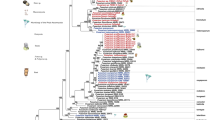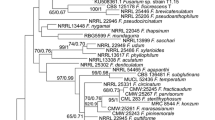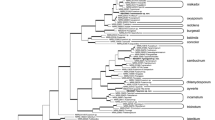Abstract
Fusarium species exhibit diverse lifestyles, being commonly encountered as saprotrophs and endophytes, but can also act as pathogens to plants, animals, including humans, and even other fungi. Very little is known, however, about the species diversity of fungicolous Fusarium species. The following study thus aimed to characterize species of Fusarium and related genera associated with smut fungi and mushrooms in Iran by applying a polyphasic approach involving culture characteristics, morphology, and multigene phylogenetic analyses. Twenty-four fungicolous isolates were recovered from different host species spanning four host families in the Eastern Azerbaijan provinces of north and northwest Iran. Isolates belonged to four Fusarium species complexes (SC) in, i.e., F. fujikuroi SC, F. oxysporum SC, F. incarnatum-equiseti SC, and F. tricinctum SC. One other fungicolous taxon was identified as Neocosmospora metavorans. Two new lineages belonging to the F. tricinctum SC are here described as F. gamsii and F. iranicum, both species occurring on Agaricus bisporus. Fusarium gamsii is phylogenetically related to F. torulosum, and F. iranicum to F. flocciferum. Morphological characters support their distinction from their closest phylogenetic sister species. Additionally, A. bisporus and Boletus sp. are here listed as new host records for members of the F. tricinctum SC in Iran.






Similar content being viewed by others
References
Al-Hatmi AMS, Hagen F, Menken SBJ, Meis JF, de Hoog GS (2016) Global molecular epidemiology and genetic diversity of Fusarium, a significant emerging group of human opportunists from 1958 to 2015. Emerg Microbes Infec 5:e124
Aoki T, O’Donnell K, Homma Y, Lattanzi AR (2003) Sudden-death syndrome of soybean is caused by two morphologically and phylogenetically distinct species within the Fusarium solani species complex—F. virguliforme in North America and F. tucumaniae in South America. Mycologia 95:660–684
Aoki T, O’Donnell K, Scandiani MM (2005) Sudden death syndrome of soybean in South America is caused by four species of Fusarium: Fusarium brasiliense sp. nov., F. cuneirostrum sp. nov., F. tucumaniae and F. virguliforme. Mycologia 46:162–183
Aoki T, O’Donnell K, Geiser DM (2014) Systematics of key phytopathogenic Fusarium species: current status and future challenges. J Gen Plant Pathol 80:189–201
Arora DK, Dwivedi RS (1980) Mycoparasitism of Fusarium spp. on Rhizoctonia solani Kühn. Plant Soil 55:43–53
Bakhshi M, Arzanlou M, Babai-Ahari A (2011) Uneven distribution of mating type alleles in Iranian populations of Cercospora beticola, the causal agent of Cercospora leaf spot disease of sugar beet. Phytopathol Mediterr 50:101–109
Bhat R, Ravishankar VR, Karim AA (2009) Mycotoxins in food and feed: present status and future concerns. Compr Rev Food Sci Food Saf 9:57–81
Carbone I, Kohn LM (1999) A method for designing primer sets for speciation studies in filamentous ascomycetes. Mycologia 91:553–556
Chenthamara K, Druzhinina IS (2016) 12 Ecological genomics of mycotrophic fungi. In: Druzhinina I., Kubicek C. (eds) Environmental and microbial relationships. The Mycota (a comprehensive treatise on fungi as experimental systems for basic and applied research), vol 4 Springer, Cham
Crous PW, Verkley GJM, Groenewald JZ, Samson RA (2009) Fungal biodiversity. CBS Laboratory manual series 1. Centraalbureau voor Schimmelcultures, Utrecht, pp 1–269
Edwards J, Auer D, De Alwis SK et al (2016) Fusarium agapanthi sp. nov., a novel bikaverin and fusarubin-producing leaf and stem spot pathogen of Agapanthus praecox (African lily) from Australia and Italy. Mycologia 108:981–992
Ershad D (2009) Fungi of Iran, 3rd edn. Iranian Research Institution of Plant Protection, Tehran
Fisher NL, Burgess LW, Toussoun TA, Nelson PE (1982) Carnation leaves as a substrate and for preserving cultures of Fusarium species. Phytopathology 72:151–153
Gams W, Diederich P, Põldamaa K (2004) Fungicolous fungi. In: Mueller GM, Bills GF, Foster MS (eds) Biodiversity of fungi inventory and monitoring methods. Elsevier Academic Press, USA, pp 343–392
Gerlach W, Nirenberg HI (1982) The genus Fusarium – a pictorial atlas. Mitt Biol Bundesanst Land- und Forstwirtsch Berlin-Dahlem 209:1–406
Gräfenhan T, Schroers HJ, Nirenberg HI, Seifert KA (2011) An overview of the taxonomy, phylogeny, and typification of nectriaceous fungi in Cosmospora, Acremonium, Fusarium, Stilbella, and Volutella. Stud Mycol 68:79–113
Groenewald JZ, Nakashima C, Nishikawa J, Shin HD, Park JH, Jama AN, Groenewald M, Braun U, Crous PW (2013) Species concepts in Cercospora: spotting the weeds among the roses. Stud Mycol 75:115–170
Gupta RC, Upadhyay RS, Rai B (1979) Hyphal parasitism and chlamydospore formation by Fusarium oxysporum on Rhizoctonia solani. Mycopathologia 67:147–152
Hoch HC, Abawi GS (1979) Mycoparasitism of oospores of Phytium ultimum by Fusarium merismoides. Mycologia 71:370–379
Hornok L, Walcz I (1983) Fusarium heterosporum, a highly specialized hyperparasite of Claviceps purpurea. Trans Brit Mycol Soc 80:377–380
Katoh K, Standley DM (2013) MAFFT multiple sequence alignment software version 7: improvements in performance and usability. Mol Biol Evol 30:772–780
Leslie JF, Summerell BA (2006) The Fusarium laboratory manual. Blackwell Publishing, Ames
Li W, Cowley A, Uludag M et al (2015) The EMBL-EBI bioinformatics web and programmatic tools framework. Nucleic Acids Res 43:W580–W584
Liu YJ, Whelen S, Hall BD (1999) Phylogenetic relationships among ascomycetes: evidence from an RNA polymerase II subunit. Mol Biol Evol 16:1799–1808
Lombard L, van der Merwe NA, Groenewald JZ, Crous PW (2015) Generic concepts in Nectriaceae. Stud Mycol 80:189–245
Lugtenberg B, Rozen DE, Kamilova F (2017) Wars between microbes on roots and fruits. F1000Research 6(F1000 Faculty Rev):343
Miller MA, Pfeiffer W, Schwartz T (2012) The CIPRES science gateway: enabling high-impact science for phylogenetics researchers with limited resources. In: Proceedings of the 1st Conference of the Extreme Science and Engineering Discovery Environment: bridging from the extreme to the campus and beyond. Association for Computing Machinery, USA, pp 1–8
Mower RL, Snyder WC, Hancock JG (1975) Biological control of ergot by Fusarium. Phytopathology 65:5–10
Nirenberg HI (1976) Untersuchungen über die morphologische und biologische Differenzierung in der Fusarium-Section Liseola. Mitt Biol Bundesanst Land- und Forstwirtschaft Berlin-Dahlem 169:1–117
Nugent LK, Sangvichen EK, Sihanonth P, Ruchikachorn N, Whalley AJS (2006) A revised method for the observation of conidiogenous structures in fungi. Mycologist 20:111–114
Nylander JAA (2004) MrModeltest v2.0. Program distributed by the author. Evolutionary Biology Centre, Uppsala University, Uppsala, Sweden
O’Donnell K, Cigelnik E (1997) Two divergent intragenomic rDNA ITS2 types within a monophyletic lineage of the fungus Fusarium are nonorthologous. Mol Phylogenet Evol 7:103–116
O’Donnell K, Cigelnik E, Nirenberg H (1998a) Molecular systematics and phylogeography of the Gibberella fujikuroi species complex. Mycologia 90:465–493
O’Donnell K, Kistler HC, Cigelnik E, Ploetz RC (1998b) Multiple evolutionary origins of the fungus causing Panama disease of banana: concordant evidence from nuclear and mitochondrial gene genealogies. Proc Natl Acad Sci U S A 95:2044–2049
O’Donnell K, Nirenberg HI, Aoki T, Cigelnik E (2000) A multigene phylogeny of the Gibberella fujikuroi species complex: detection of additional phylogenetically distinct species. Mycoscience 41:61–78
O’Donnell K, Sutton DA, Rinaldi MG, Gueidan C, Crous PW, Geiser DM (2009) Novel multilocus sequence ty** scheme reveals high genetic diversity of human pathogenic members of the Fusarium incarnatum-F. equiseti and F. chlamydosporum species complexes within the United States. J Clin Microbiol 47:3851–3861
O'Donnell K, Sutton DA, Rinaldi MG, Sarver BAJ, Arunmozhi Balajee S, Schroers HJ, Summerbell RC, Robert VARG, Crous PW, Zhang N, Aoki T, Jung K, Park J, Lee YH, Kang S, Park B, Geiser DM (2010) Internet-accessible DNA sequence database for identifying fusaria from human and animal infections. J Clin Microbiol 48:3708–3718
O'Donnell K, Sutton DA, Wiederhold N, Robert VA, Crous PW, Geiser DM (2016) Veterinary fusarioses within the United States. J Clin Microbiol 54:2813–2819
Quaedvlieg W, Kema GHJ, Groenewald JZ, Verkley GJM, Seifbarghi S, Razavi M, Mirzadi Gohari A, Mehrabi R, Crous PW (2011) Zymoseptoria gen. nov.: a new genus to accommodate Septoria-like species occurring on graminicolous hosts. Persoonia 26:57–69
Rayner RW (1970) A mycological colour chart. CMI and British Mycological Society. In: Kew. Surrey, England
Sandoval-Denis M, Crous PW (2018) Removing chaos from confusion: assigning names to common human and animal pathogens in Neocosmospora. Persoonia 41:109–129
Sandoval-Denis M, Guarnaccia V, Polizzi G, Crous PW (2018) Symptomatic Citrus trees reveal a new pathogenic lineage in Fusarium and two new Neocosmospora species. Persoonia 40:1–25
Schroers HJ, Gräfenhan T, Nirenberg HI, Seifert KA (2011) A revision of Cyanonectria and Geejayessia gen. nov., and related species with Fusarium-like anamorphs. Stud Mycol 68:115–138
Sneh B, Humble SJ, Lockwood JL (1977) Parasitism of oospores of Phytophthora megasperma var. sojae, P. cactorum, Phytium sp. and Aphanomyces euteiches in soil by Oomycetes, Chytridiomycetes, Hyphomycetes, Actinomycetes and bacteria. Phytopathology 67:622–628
Snyder WC, Hansen HN (1947) Advantages of natural media and environments in the culture of fungi. Phytopathology 37:420–421
Sung GH, Sung JM, Hywel-Jones NL, Spatafora JW (2007) A multi-gene phylogeny of Clavicipitaceae (Ascomycota, fungi): identification of localized incongruence using a combinational bootstrap approach. Mol Phylogenet Evol 44:1204–1223
Swofford DL (2002) PAUP*. Phylogenetic Analysis Using Parsimony (*and other methods). Version 4. Sinauer Associates, Sunderland, Massachusetts, USA
Tamura K, Stecher G, Peterson D, Filipski A, Kumar S (2013) MEGA6: molecular evolutionary genetics analysis version 6.0. Mol Biol Evol 30:2725–2729
Vajna L (1984) Phytopathogenic Fusarium oxysporum Schlecht. as a necrotrophic mycoparasite. J Phytopathol 114:338–347
Van Diepeningen AD, Al-Hatmi AMS, Brankovics B, Sybren de Hoog G (2014) Taxonomy and clinical spectra of Fusarium species: where do we stand in 2014? Current Clinical Microbiology Reports 1:10–18
Vilgalys R, Hester M (1990) Rapid genetic identification and map** of enzymatically amplified ribosomal DNA from several Cryptococcus species. J Bacteriol 172:4238–4246
Vilgalys R, Sun BL (1994) Ancient and recent patterns of geographic speciation in the oyster mushroom Pleurotus revealed by phylogenetic analysis of ribosomal DNA sequences. Proc Natl Acad Sci U S A 91:4599–4603
White TJ, Bruns T, Lee S, Taylor JW (1990) Amplification and direct sequencing of fungal ribosomal RNA genes for phylogenetics. In: Innes MA, Gelfand DH, Sninsky et al (eds) PCR protocols: a guide to methods and applications. Academic Press, USA, pp 315–322
Wollenweber HW, Reinking OA (1935) Die Fusarien, ihre Beschreibung, Schadwirkung und Bekämpfung. Paul Parey, Berlin
Woudenberg JHC, Aveskamp MM, De Gruyter J, Spiers AG, Crous PW (2009) Multiple Didymella teleomorphs are linked to the Phoma clematidina morphotype. Persoonia 22:56–62
Wynn AR, Epton HAS (1979) Parasitism of oospores of Phytophthora erythroseptica in soil. Trans Brit Mycol Soc 73:255–259
Zare R, Asef M (2008) Some phialidic fungicolous fungi from the Southern Caspian coasts. Rostaniha 9:1–22
Zare R, Khabbaz-Jolfaei H (2005) Fungi isolated from Agaricus bisporus in Tehran province with special reference to Verticillium fungicola. Rostaniha 6:17–29
Acknowledgements
We gratefully acknowledge the Research Deputy of the Iranian Research Institute of Plant Protection, the University of Tabriz, for financial support.
Author information
Authors and Affiliations
Corresponding author
Additional information
Section Editor: Marc Stadler
This article is part of the "Special Issue on hyphomycete taxonomy and diversity in honour of Walter Gams who passed away in April 2017”
Electronic supplementary material
ESM 1
(DOCX 50 kb)
Rights and permissions
About this article
Cite this article
Torbati, M., Arzanlou, M., Sandoval-Denis, M. et al. Multigene phylogeny reveals new fungicolous species in the Fusarium tricinctum species complex and novel hosts in the genus Fusarium from Iran. Mycol Progress 18, 119–133 (2019). https://doi.org/10.1007/s11557-018-1422-5
Received:
Revised:
Accepted:
Published:
Issue Date:
DOI: https://doi.org/10.1007/s11557-018-1422-5




